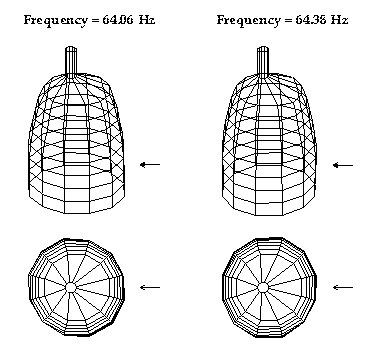Yang-Hann Kim - yhkim@sorak.kaist.ac.kr
Center for Noise and Vibration Control
Department of Mechanical Engineering, KAIST
373-1 Science Town, Taejon-shi
Korea
http://novic.kaist.ac.kr/yhklab/
Popular version of paper 2pMU4
Presented Tuesday afternoon, June 17, 1997
133rd ASA Meeting, State College, PA
Embargoed until June 17 1997
The bells which were cast during the Silla(BC 57? - AD 935) and Korea dynasty(AD 936 - 1392) used to be hung over various types of hollows or cavities on the ground. The most popular shape is a hemisphere. The sound pipe called the "eumtong" which opens through the top also appears in most of the bells. Another geometrical characteristic of the bells is that the diameter of the bell mouth is not the largest: usually the diameter of the circular cross section of which is little bit above the mouth is the largest. However, the acoustic characteristics of the bell, which are obviously related with geometrical features as well as with mechanical properties, have not been well described in terms of scientific and physical terms. One very well known characteristic of the bells is their very long beating frequency; sometimes more than 3 seconds. The King Song-Dok bell ("Emille" bell) cast during the Silla dynasty; 771 AD, is the most famous one among them. Its height is 3.66 m, the diameter of bell mouth is 2.23 m, and its mass is about 20,000 kg. It is believed that Emille earns her fame for several reasons. One is due to the delicate, and beautiful various kinds of cast expressions on the bell; two examples are lotuses and beechunsang (which depicts a holy woman rising to the heavens). The other one is obviously due to her sound. The aim of this paper is to investigate the origins of Emille's sound.
For practical reasons, it has not been possible until recently to obtain the necessary data to analyze the acoustic characteristics of the bell. This is simply because the government cannot allow any action which might possibly damage the bell. However, very recently, the government has realized that a state-of-the-art scientific investigation would provide the best way to protect her as long as possible. This gave us a chance to strike the bell, which was done as a part of the project to investigate the total value of the bell, from an artistic to scientific perspective. To maximize this valuable chance, a very extensive experiment was designed and conducted. To understand how the bell radiates sound, measurements were made yielding "cylindrical acoustic holgraphs" which allows one to visualize the bell's ringing properties. To make these measurements, 32 microphones were used which were separated by 15 cm, at every 30 degrees of the bell's circumference. The accelerations of the bell as it vibrated were also measured at many points; there were 11 accelerometers at every 30 degrees. The acoustic characteristics of inside of the bell were also measured. This was done to see the relation between the internal sound field and the external, radiating sound field. This paper addresses the role of acoustic cavity in the ground, sound pipe, and the source of long beating.
The experimental results suggested that the long beating frequencies are due to asymmetric characteristics of the bell. The sources of asymmetry could be geometrical, or material properties, or more generally mechanical asymmetry. This asymmetry produces a pair of normal modes, whose natural frequencies are very close to each other. The striker of the bell was found to impact the bell where it can effectively excite every pair of modes. The beating period for the lowest pair is about 3 seconds, and that of the next is about 9 seconds. The fundamental frequencies of the internal acoustic field are not well matched with the natural frequencies of the bell, which is different with what most of the researchers expected. This suggests that the present hollow on the ground is not what actually was designed for the bell; the bell was moved from the old gate of Kyung-ju City, where the bell has a much larger hollow than the present one. The role of the hollow is obviously to amplify the bell's sound. As for the experimental results concerning the sound pipe, the radiation impedance was measured as well as the reflection coefficient of the pipe, reveals that its function is to filter out high frequency sound; above 300 Hz. Another possible name for this pipe would be a "mechanical damper" since it dissipates high frequency sound, even though it is very small.
Sound visualization based on the holographic measurements demonstrates how its sound radiates in space. The vibration characteristics are also demonstrated.
(To view these animated GIFs, we recommend using Netscape Navigator 3.0 or higher or Microsoft Internet Explorer 3.0 or higher.)

